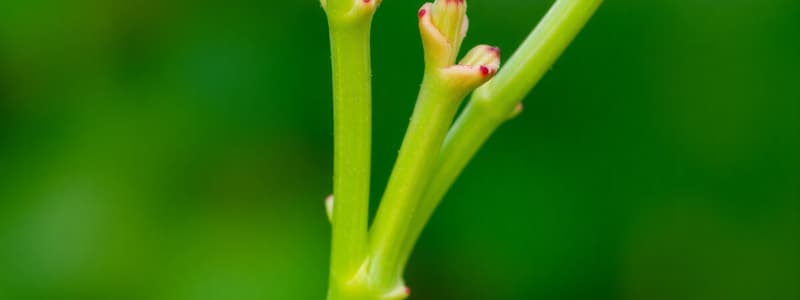Podcast
Questions and Answers
What is the primary function of stems in plants?
What is the primary function of stems in plants?
- Storing food
- Photosynthesis
- Reproduction
- Transporting nutrients and water (correct)
Which type of stem grows flat on the ground and is identified as a creeper?
Which type of stem grows flat on the ground and is identified as a creeper?
- Prostate stem (correct)
- Twinner
- Woody stem
- Climber
What type of stem is typically hard and often provides structural support to plants?
What type of stem is typically hard and often provides structural support to plants?
- Herbaceous stem
- Weak stem
- Woody stem (correct)
- Creeping stem
Where on the stem can you find the axillary bud?
Where on the stem can you find the axillary bud?
Which leaf arrangement involves leaves that spiral around the stem?
Which leaf arrangement involves leaves that spiral around the stem?
What do the scales of terminal buds indicate?
What do the scales of terminal buds indicate?
Which part of a plant's stem is responsible for the growth in length during the growing season?
Which part of a plant's stem is responsible for the growth in length during the growing season?
What type of stem typically has a thin and long structure lacking the ability to stand upright?
What type of stem typically has a thin and long structure lacking the ability to stand upright?
What is the primary function of the apical meristem?
What is the primary function of the apical meristem?
Which type of meristem develops into the epidermis of the stem?
Which type of meristem develops into the epidermis of the stem?
What distinguishes woody dicotyledons from herbaceous dicotyledons?
What distinguishes woody dicotyledons from herbaceous dicotyledons?
Which term describes the older, non-conductive wood found at the center of a tree?
Which term describes the older, non-conductive wood found at the center of a tree?
What is a defining characteristic of monocotyledonous stems?
What is a defining characteristic of monocotyledonous stems?
Which type of underground modification of stems is characterized by swollen structures with 'eyes' or vegetative buds?
Which type of underground modification of stems is characterized by swollen structures with 'eyes' or vegetative buds?
What is the primary function of conducting tissues in stems?
What is the primary function of conducting tissues in stems?
Which of the following modifications of stems is characterized by horizontal growth and roots at the nodes?
Which of the following modifications of stems is characterized by horizontal growth and roots at the nodes?
Flashcards are hidden until you start studying
Study Notes
General Structure of Stems
- Stems develop from the plumule and are key to the plant’s aerial structure.
- Stems consist of an ascending axis, nodes, internodes, and buds.
- Types of stems include aerial, sub-aerial, and underground variations.
- Mechanical classifications include weak, herbaceous, and woody stems.
Weak Stems
- Creepers grow flat on the ground, e.g., grasses.
- Climbers require support and use tendrils or hooks, e.g., Piper betel.
- Twinners coil around supports, e.g., Ipomoea.
Herbaceous and Woody Stems
- Herbaceous stems are soft, e.g., sunflowers; woody stems are hard, e.g., mango trees.
- Functions include photosynthesis through leaf production and nutrient transport.
External Structure of Stems
- Woody twigs feature an axis with attached leaves.
- Leaf arrangements: alternate (spiral), opposite (pairs), and whorled (groups).
- Nodes are where leaves attach; internodes are the spaces between nodes.
- Leaves consist of a blade and are attached via a petiole.
- Axillary buds develop in the axil, potentially forming flowers or branches.
- Terminal buds, larger than axillary ones, promote twig lengthening.
Leaf and Bud Scars
- Scars from terminal buds indicate twig age and history.
- Stipule scars may encircle the twig or be inconspicuous.
- Deciduous trees show dormant axillary buds with visible leaf scars post-fall.
- Tiny bundle scars indicate vascular tissue locations within leaf scars.
Internal Structures of Stems
- Apical meristem is located at the stem tip, responsible for growth; protected by scales and leaf primordia.
- Primary meristems include:
- Protoderm: forms epidermis and cuticle.
- Procambium: produces primary xylem (for water) and phloem (for nutrients).
- Ground meristem: develops pith and cortex (for storage).
Lateral Meristems
- Vascular cambium adds girth, producing secondary xylem and phloem.
- Cork cambium (Phellogen) produces protective cork.
Types of Steles
- Protostele: solid core of conducting tissues.
- Siphonostele: tubular with vascular tissue at the center.
- Eustele: arranged vascular bundles.
Woody vs. Herbaceous Stems
- Herbaceous dicotyledons have primarily primary tissues; woody dicotyledons develop secondary tissues, visible as annual rings.
Growth Rings
- Spring wood has larger vessels and a lighter color, while summer wood is darker with smaller vessels.
Heartwood vs. Sapwood
- Heartwood is non-conductive, older wood at the center; sapwood is younger and functional near the cambium.
Monocotyledonous Stems
- Lack vascular or cork cambium, producing no secondary tissue with vascular bundles scattered throughout.
Functions of Stems
- Conducting tissues include xylem (water transport) and phloem (nutrient transport).
- Cork and bark provide protection; wood offers structural support.
- Pith and cortex serve as storage locations for nutrients.
Stem Modifications
Underground Modifications
- Rhizome: Horizontal growth with thick structures and nodes, e.g., ginger.
- Tuber: Swollen structures with vegetative buds (eyes), e.g., potatoes.
- Bulb: Food stored in fleshy scales; new plants develop in spring, e.g., garlic.
- Corm: Stout vertical structure with buds in axils and adventitious roots, e.g., saffron.
Sub-aerial Modifications
- Runner: Creeping growth that roots at nodes, e.g., strawberries.
- Stolon: Lateral branches grow horizontally with nodes and internodes, e.g., jasmine.
- Offsets: Short, thick horizontal stems producing new plants.
Studying That Suits You
Use AI to generate personalized quizzes and flashcards to suit your learning preferences.




